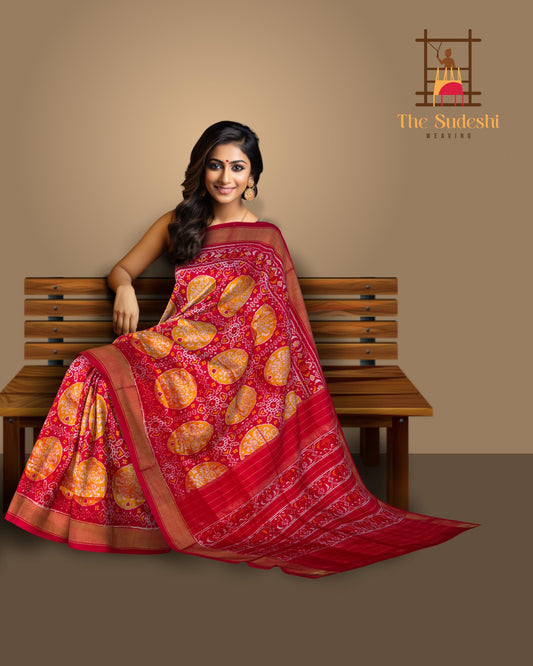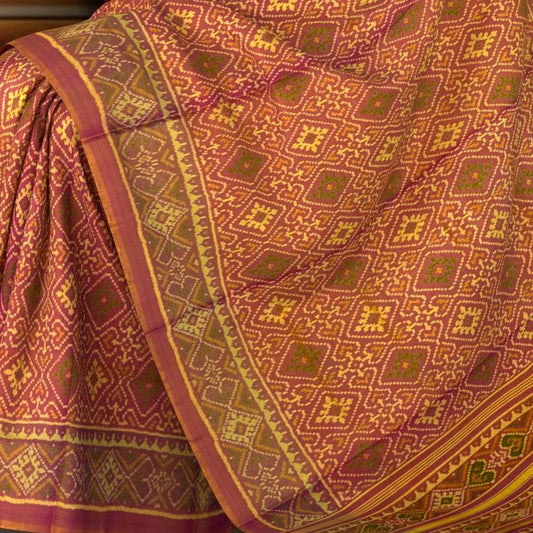The Art of Patola: A Deep Dive into Materials, Dyes, and Tools
Patola sarees, with their intricate geometric patterns and vibrant hues, are a testament to the artistry and heritage of India. Woven in the heart of Gujarat, these exquisite textiles are a captivating blend of tradition and craftsmanship. This article delves into the fascinating world of Patola, exploring the unique materials, natural dyes, and specialized tools that contribute to its unparalleled beauty.
The Silk Foundation: Unveiling the Types Used in Patola Sarees
Patola sarees are renowned for their luxurious feel and drape, which are attributed to the exceptional quality of silk used in their weaving. Here's a closer look at the types of silk commonly employed:
- Patolu Silk: This is the most sought-after silk for Patola sarees. It's known for its exceptional fineness, luster, and durability. Patolu silk is a unique variety of mulberry silk cultivated in the Patan region of Gujarat, where Patola weaving originated.
- Mulberry Silk: This is another common type of silk used in Patola weaving. It's renowned for its smooth texture, lustrous sheen, and strength. Mulberry silk is produced from the cocoons of silkworms that feed on mulberry leaves.
- Tussah Silk: Also known as wild silk, Tussah silk is a more rustic and durable variety. It has a distinctive natural color and a slightly coarser texture compared to mulberry silk. While less common in Patola weaving, Tussah silk is occasionally used for specific designs or to add a touch of rustic charm.
The Allure of Natural Dyes: A Palette of Vibrant Hues
Patola sarees are known for their captivating array of colors, all achieved using natural dyes derived from plants, minerals, and insects. Here are some prominent natural dyes and their sources:
- Indigo: This deep blue dye is extracted from the leaves of the indigo plant. It's a key component in many Patola designs, creating striking contrasts and enriching the overall aesthetic.
- Madder: This vibrant red dye is obtained from the roots of the madder plant. It's used to create deep red hues and is often combined with indigo to achieve a rich burgundy shade.
- Saffron: This precious spice, derived from the stigma of the saffron flower, yields a vibrant yellow dye. Saffron is often used in Patola weaving to create intricate patterns and add a touch of luxury.
- Turmeric: This common spice provides a bright yellow dye. It's often used in conjunction with other dyes to create a variety of shades and enhance the vibrancy of the fabric.
Specialized Tools: The Craftsman's Arsenal
The creation of a Patola saree is a labor of love and skill, relying on specialized tools that have been passed down through generations. Here are some of the unique tools essential to Patola weaving:
- Patola Loom: This traditional handloom is meticulously crafted and designed specifically for Patola weaving. Its intricate structure allows for the creation of the complex double-ikat designs that define Patola sarees.
- Warping Frame: This tool is used to prepare the warp threads, which are the longitudinal threads of the fabric. The warping frame ensures that the threads are evenly spaced and ready for weaving.
- Heald Sticks: These specialized sticks are used to control the warp threads, enabling the weaver to create intricate patterns by raising and lowering different sets of threads.
- Shuttle: The shuttle is a wooden or bamboo tool that carries the weft threads, which are woven horizontally across the warp threads. Patola weavers use specialized shuttles designed to handle the fine silk yarns.
Conclusion: A Legacy of Artistic Excellence
The art of Patola weaving is a testament to the enduring spirit of craftsmanship. The use of exquisite silk, natural dyes, and specialized tools allows weavers to create breathtaking masterpieces that embody the rich cultural heritage of India. From the intricate patterns to the vibrant hues, every detail of a Patola saree reflects the dedication and artistry of its creators.







Leave a comment
Please note, comments need to be approved before they are published.